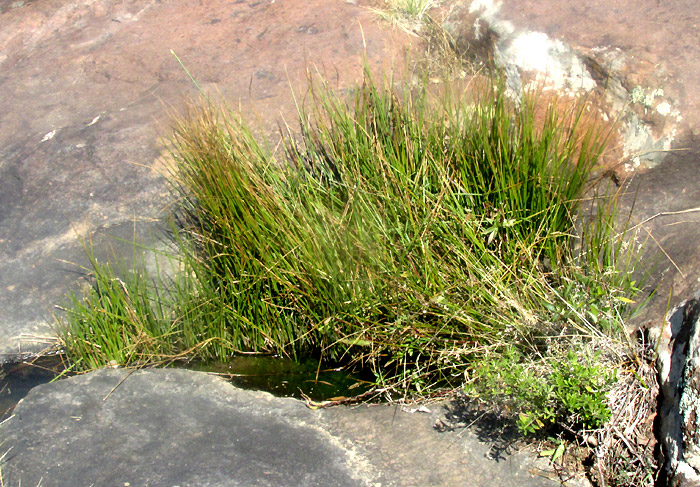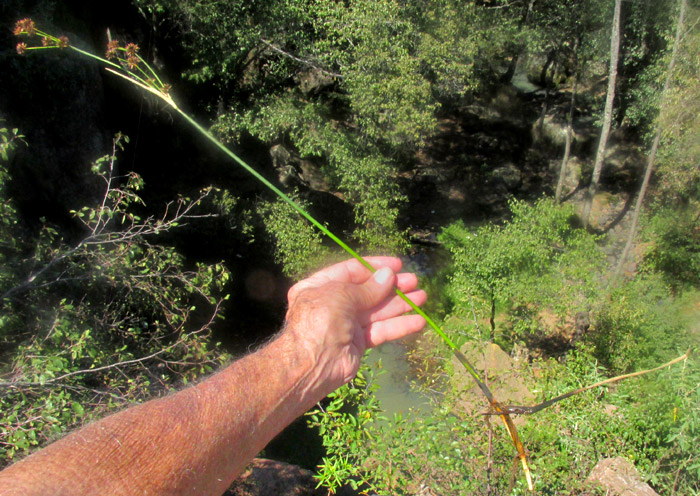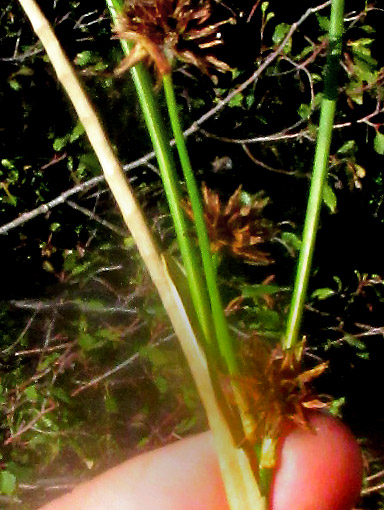Excerpts from Jim Conrad's
Naturalist Newsletter
Entry dated November 7, 2023, from notes taken at Cascadas de La Piedad waterfall 3kms NW of the community of San Pablo, municipality of Almeaco de Bonfil; bedrock of igneous andesite; N20.1008°, W100.0041°, elevation 2360 meters (7750ft); extreme southern Querétaro state, MÉXICO
JUNCUS EBRACTEATUS

Even during the ongoing two-year dry period classified by the "North American Drought Monitor" as an extreme D3 drought, a small stream of clear, cold water meandered across a livestock-grazed meadow atop a bed of pinkish, igneous andesite rock. Just before tumbling over a high ledge to create the picturesque Cascada de La Piedad, or Piety Waterfall, the above dense, knee-high colony of rushes was thriving.
Rushes are monocots, like grasses, sedges and orchids. About 300 rush species, genus Juncus, are recognized worldwide, with most species occurring in cold or wet habitats; in the tropics, they're mostly mountain species. At a distance, certain sedges and even spore-producing horsetails can look like rushes. Above, among the hundreds of close-growing stems, only a couple of flowering stems made the rush identity clear. The colony's growth pattern suggests that this species develops rhizomes sprouting stems along their lengths.

The above flowering stem is topped by a typical rush inflorescence composed of roundish flowering heads on long stalks. Note that near the stem's base a mostly decomposed leaf arises a little above the base. Four of the eleven rush species documented by the Flora del Bajío for our highland, central Mexican region bear no leaves on their stems, so this is a helpful field mark.

At the right, it's seen that below each cluster of long-stalked heads, a dried-out, leaf-like bract arises, occupying the picture's left side. Note that the bract is cylindrical, not flat as with many rush species. Moreover, you can barely see that the cylindrical blade is segmented -- has wall-like partitions between the cylinder's empty segments, keeping the blade from collapsing. This segmentation also disqualifies several species. Blade margins at the bract's base enlarge into wing-like appendages.

Juncus flowers usually produce six tepals, sometimes fewer, the term tepal used when the calyx's sepals and the corolla's lobes or petals are indistinguishable. Though most of our plant's flowers are past their main flowering time, at the above picture's far left and far right edges, notice that two flowers still bear dark gray, curling, dried-out stigmas atop relatively long, slender styles. On most flowers the styles with their stigmas have fallen off, leaving maturing ovaries or immature capsular fruits whose gradually narrowing tops extend well beyond the sepals' tips. Such a long, narrow neck or beak is best seen at about 11 o'clock on the above head, and this is one of the best field marks for this species. Also, flowering heads on this species often are spherical, with lower flowers pointing downward, while on most Juncus species the heads are only partly spherical, with no down-pointing lower flowers.
All the above features lead us JUNCUS EBRACTEATUS, with no English name. The species occurs throughout upland Mexico and Guatemala, and again in a disjunct population in South America's Andes region. It grows in waterlogged soil and flooded parts of grassy swales, meadows, riverbeds and along creeks.
I'm a little uncomfortable with this identification because the Flora del Bajío describes the flowering heads as containing not more than 35 flowers -- other descriptions say fewer -- while our heads bear more than that. Also, I find no pictures of this species showing many stems so tightly packed next to one another. However, all other details lead to Juncus ebracteatus, and there seems to be no other candidate.
I find no information about human uses of Juncus ebracteatus, though it's commonly known that in many cultures rushes of various species have been used for basket weaving, thatching, tying and binding, and in sacred ceremonies. Since ancient times, rush stems of various species have been stripped of their tough outer fiber to expose the pith, which was dried, then soaked in oil or grease and placed in or on special kinds of holders, to make "rushlights," which are well described on Wikipedia's Rushlight page.